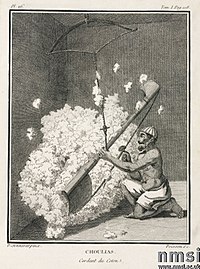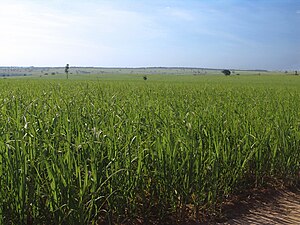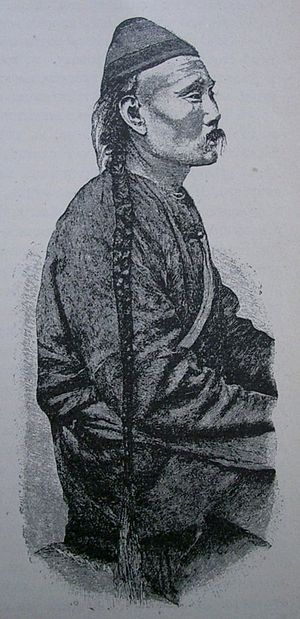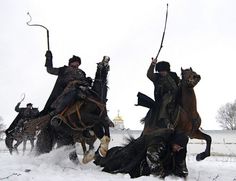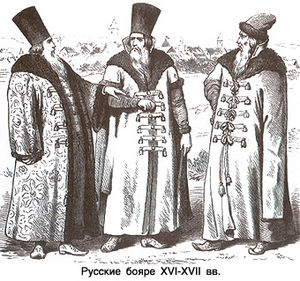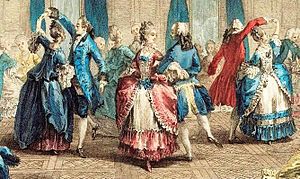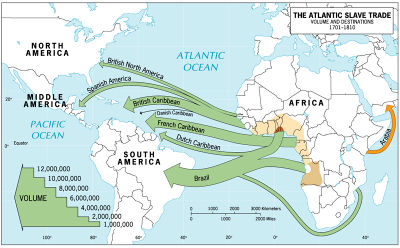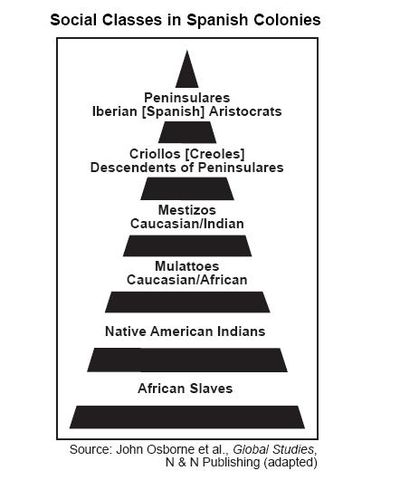Key Concept 4.2 New Forms of Social Organization and Modes of Production
"Although the world’s productive systems continued to be heavily centered on agricultural production throughout this period, major changes occurred in agricultural labor, the systems and locations of manufacturing, gender and social structures, and environmental processes. A surge in agricultural productivity resulted from new methods in crop and field rotation and the introduction of new crops. Economic growth also depended on new forms of manufacturing and new commercial patterns, especially in long-distance trade. Political and economic centers within regions shifted, and merchants’ social status tended to rise in various states. Demographic growth — even in areas such as the Americas, where disease had ravaged the population — was restored by the eighteenth century and surged in many regions, especially with the introduction of American food crops throughout the Eastern Hemisphere. The Columbian Exchange led to new ways of humans interacting with their environments. New forms of coerced and semi-coerced labor emerged in Europe, Africa, and the Americas, and affected ethnic and racial classifications and gender roles." [1]
- I. Beginning in the 14th century, there was a decrease in mean temperatures, often referred to as the Little Ice Age, around the world that lasted until the 19th century, contributing to changes in agricultural practices and the contraction of settlement in parts of the Northern Hemisphere.
- II. Traditional peasant agriculture increased and changed, plantations expanded, and demand for labor increased. These changes both fed and responded to growing global demand for raw materials and finished products.
- A. In this time period peasant labor increased. Powerful states made use of peasants for their economic and political prerogatives. To secure the new frontier settlements to the east that had growing since Ivan IV, Russian Czars encouraged peasants to migrate to Siberia. They were provided with incentives, such as grain, seeds, and farming tools. Many peasants sought to create a better and more independent life for themselves by moving east. Fur trappers pushed to the east as well to take advantage in the profitable trade in furs. For the most part, however, the eastern frontier was settled by peasants who were encouraged to migrate by the Russian government.
- A. In this time period peasant labor increased. Powerful states made use of peasants for their economic and political prerogatives. To secure the new frontier settlements to the east that had growing since Ivan IV, Russian Czars encouraged peasants to migrate to Siberia. They were provided with incentives, such as grain, seeds, and farming tools. Many peasants sought to create a better and more independent life for themselves by moving east. Fur trappers pushed to the east as well to take advantage in the profitable trade in furs. For the most part, however, the eastern frontier was settled by peasants who were encouraged to migrate by the Russian government.
- During the Mughal empire, the price of spices declined. To maintain their profits, joint-stock companies such as the British East India Company and the Dutch VOC encouraged Mughal leaders to supplement pepper exports with cotton textiles. Cotton, which was softer than many fabrics and could be dyed and printed with elaborate patterns, became an extremely popular fad in Europe. To meet this demand, the Mughal government forced a vast number of peasants to work cotton fields and textile operations. As in Russia, state mandates and incentives led to the mass mobilization of peasants to aid state objectives.
- During the Mughal empire, the price of spices declined. To maintain their profits, joint-stock companies such as the British East India Company and the Dutch VOC encouraged Mughal leaders to supplement pepper exports with cotton textiles. Cotton, which was softer than many fabrics and could be dyed and printed with elaborate patterns, became an extremely popular fad in Europe. To meet this demand, the Mughal government forced a vast number of peasants to work cotton fields and textile operations. As in Russia, state mandates and incentives led to the mass mobilization of peasants to aid state objectives.
- The Qing (Manchu) Empire likewise utilized peasants for their economic gain. Even though they focused China’s economic strength more on the practice of agriculture than commerce, silk exports became important to their economy. The city of Canton in the south of China was the only location where Europeans were allowed to conduct business and the Chinese accepted only gold and silver as payment for their exports. To meet the demand of foreigners for silk, the government forced peasants to work in the growing of mulberry plants (necessary for silk worms to produce quality silk) and in the general production of silk. In some areas, silk production exceeded rice production and consumed all surplus labor of peasant families. [2]
- The Qing (Manchu) Empire likewise utilized peasants for their economic gain. Even though they focused China’s economic strength more on the practice of agriculture than commerce, silk exports became important to their economy. The city of Canton in the south of China was the only location where Europeans were allowed to conduct business and the Chinese accepted only gold and silver as payment for their exports. To meet the demand of foreigners for silk, the government forced peasants to work in the growing of mulberry plants (necessary for silk worms to produce quality silk) and in the general production of silk. In some areas, silk production exceeded rice production and consumed all surplus labor of peasant families. [2]
- B. Despite all the dramatic changes in labor during this period, Africa continued to supply slaves to the Indian Ocean and the Mediterranean as it did in previous periods. Records of the slave trade in Africa date back to 2900 B.C.E. when slaves were transported from Sub-Saharan Africa to Nubia. [3] As the slave trade grew tremendously in the Atlantic system to supply plantation labor in the Americas, the movement of African slaves to the Mediterranean and Indian Ocean regions was an important continuity with the past.
- C. The Portuguese colony of Brazil was the first to implement the plantation system in the New World. A plantation is a large commercial farm used to grow a single cash crop for export. First tobacco, and then sugar became the most lucrative crops in this system. But indigenous labor did not work well as many native Americans succumbed to diseases carried by the European plantation managers. Europeans looked to Africa. With the growth of the plantation system the demand for African slaves increased. Over 10 million were transported across the Middle Passage of the Atlantic System.
- C. The Portuguese colony of Brazil was the first to implement the plantation system in the New World. A plantation is a large commercial farm used to grow a single cash crop for export. First tobacco, and then sugar became the most lucrative crops in this system. But indigenous labor did not work well as many native Americans succumbed to diseases carried by the European plantation managers. Europeans looked to Africa. With the growth of the plantation system the demand for African slaves increased. Over 10 million were transported across the Middle Passage of the Atlantic System.
- D. Many Europeans came to the new world to make a fortune. Without labor, the land they gained had no value in accomplishing this goal. Economic success depended on the ability to mobilize a large labor force in the service of the European colonizers. Consequently, they established a wide range of coerced labor systems in the Americas:
- D. Many Europeans came to the new world to make a fortune. Without labor, the land they gained had no value in accomplishing this goal. Economic success depended on the ability to mobilize a large labor force in the service of the European colonizers. Consequently, they established a wide range of coerced labor systems in the Americas:
- The encomienda This system was modeled after the reconquest of Iberia. In Spain, the conquistadors were granted access to Muslim labor in the areas they reconquered for the monarch (recall that much of Spain was under Muslim control for centuries). After its success in Europe, the Spanish attempted the same practice in the Americas. Land grants, called encomiendas, were given to Spanish conquistadors and soldiers and they were free to exploit the labor of the people inhabiting the land entrusted to them. Under Philip II of Spain, the encomienda system was instituted in the Spanish Philippines as well. In the Americas, the system went into decline as many natives died of diseases in close contact with Europeans.
- The encomienda This system was modeled after the reconquest of Iberia. In Spain, the conquistadors were granted access to Muslim labor in the areas they reconquered for the monarch (recall that much of Spain was under Muslim control for centuries). After its success in Europe, the Spanish attempted the same practice in the Americas. Land grants, called encomiendas, were given to Spanish conquistadors and soldiers and they were free to exploit the labor of the people inhabiting the land entrusted to them. Under Philip II of Spain, the encomienda system was instituted in the Spanish Philippines as well. In the Americas, the system went into decline as many natives died of diseases in close contact with Europeans.
- The mita system As disease rendered the encomienda system unworkable, the Spanish and Portuguese adopted a labor system from the indigenous people themselves. The mita system developed in the Inca Empire as a method of rotating groups of workers in the service of the state. When they were not working on their family farms, men between the age of 15 and 50 would provide their labor to the empire as a form of tax payment, or a corvée system. The Spanish adopted this system of labor and applied it to several contexts, especially their silver mining projects. Villages controlled by Spain had to provide a set number of people to the Spanish for labor in the mines.
- The mita system As disease rendered the encomienda system unworkable, the Spanish and Portuguese adopted a labor system from the indigenous people themselves. The mita system developed in the Inca Empire as a method of rotating groups of workers in the service of the state. When they were not working on their family farms, men between the age of 15 and 50 would provide their labor to the empire as a form of tax payment, or a corvée system. The Spanish adopted this system of labor and applied it to several contexts, especially their silver mining projects. Villages controlled by Spain had to provide a set number of people to the Spanish for labor in the mines.
- The hacienda Like the encomienda and the mita system, the haciendas generally exploited local indigenous labor. However, the hacienda was a private estate, often the result of a land grant given to an individual by the monarch. Another difference is that the hacienda produced food and good primarily for local consumption. They tended to be self-sufficient estates although many of them were economically connected to nearby encomienda with which they traded food items and hand produced goods.
- The hacienda Like the encomienda and the mita system, the haciendas generally exploited local indigenous labor. However, the hacienda was a private estate, often the result of a land grant given to an individual by the monarch. Another difference is that the hacienda produced food and good primarily for local consumption. They tended to be self-sufficient estates although many of them were economically connected to nearby encomienda with which they traded food items and hand produced goods.
- Chattel slavery Chattel slavery is what most people think of when they hear the word slavery. It is the form of labor in which the laborer is most dehumanized as he or she is considered solely as private property of the owner. Chattel slaves can be bought and sold at the owners discretion, are uncompensated, and have little chance of gaining freedom. As mentioned above, Africa provided the chattel slaves to the Americas predominately after sugar plantations, began by the Portuguese, spread across South America and the Caribbean.
- III. As new social and political elites changed, they also restructured new ethnic, racial, and gender hierarchies.
- A. The world experienced such dramatic upheavals of conquest, the movement of wealth, and new connections that societies experienced significant restructuring. In some cases new ethnic groups rose to the top of society thus replacing traditional elites.
- A. The world experienced such dramatic upheavals of conquest,
- Examples of the rise of new elites:
- Examples of the rise of new elites:
- Manchus in China In East Asia the Manchus, descendants of the Jurchen, overthrew the corrupt Ming and established the Qing Dynasty placing China once again under the yoke of a foreign ethnic group. As they ruled China they gave lip service to the Chinese idea of unity and proclaimed the "Manchu and Han are one family." [4] The reality was much different. The Manchus strove to keep themselves racially separate from the ethnic Chinese (the Han). Chinese were forbidden to learn the Manchu language and prohibited from traveling to the Manchu homeland where they might learn it. Marriage between Manchu and Han was illegal. [5] With ethnic lines clearly drawn, Manchus got preferential treatment. There was a separate court system for Manchus and prosecuting them was very difficult. If convicted, Manchus got reduced punishments and had prison cells separate from those used for all other prisoners. Although the Manchus allowed Chinese, Mongols, and minority ethnic groups in their bureaucracy, Manchus got the most prestigious appointments and higher salaries paid in silver, not copper coins like other ethnic groups were paid. [6]
- Manchus in China In East Asia the Manchus, descendants of the Jurchen, overthrew the corrupt Ming and established the Qing Dynasty placing China once again under the yoke of a foreign ethnic group. As they ruled China they gave lip service to the Chinese idea of unity and proclaimed the "Manchu and Han are one family." [4] The reality was much different. The Manchus strove to keep themselves racially separate from the ethnic Chinese (the Han). Chinese were forbidden to learn the Manchu language and prohibited from traveling to the Manchu homeland where they might learn it. Marriage between Manchu and Han was illegal. [5] With ethnic lines clearly drawn, Manchus got preferential treatment. There was a separate court system for Manchus and prosecuting them was very difficult. If convicted, Manchus got reduced punishments and had prison cells separate from those used for all other prisoners. Although the Manchus allowed Chinese, Mongols, and minority ethnic groups in their bureaucracy, Manchus got the most prestigious appointments and higher salaries paid in silver, not copper coins like other ethnic groups were paid. [6]
- Creoles in Spanish America Having just driven the Moors and Jews out of Iberia, the Spanish Conquistadors who came to the Americas were very conscious of race. The class system they established there combined the racial prejudices of Europeans with the unique circumstances of the New World. The Spanish exercised power in their American empire primarily though large landed estates (see encomienda above) though which they controlled indigenous labor and collected tribute. The owners of these estates were creoles, people of pure Spanish descent for whom the New World was their permanent home. Although peninsulares, viceroys and other bureaucrats on assignment from Spain, continued to be the colonial connection to the crown back in Europe, creoles better understood the day-to-day management of the colonies and developed their own colonial culture. The new creole elites worked in close relationship with the Roman Catholic Church which served to reinforce the hierarchical and patriarchal social order of the colonies. [7] Needless to say, the creoles grew to resent the peninsulares. They would be the driving force for independence in the revolutionary period.
- B. In addition to the rise of new elites, some empires experienced a fluctuation in power of existing elites. These traditional political and economic elites were used to being able to influence the political leaders of their empires but found it increasingly difficult to do so.
- B. In addition to the rise of new elites, some empires experienced a fluctuation in power of existing elites. These traditional political and economic elites were used to being able to influence the political leaders of their empires but found it increasingly difficult to do so.
- Examples of fluctuating power of existing elites:
- Examples of fluctuating power of existing elites:
- Russian Boyars The territorial conquests of Ivan III and Ivan IV had extended the borders of Russia before its political institutions had been fully developed; Russia was an empire before it was a state. Most power resided in local aristocrats called boyars, a class of people Ivan IV (Ivan "The Terrible") deeply distrusted. He shared the belief that the Byzantine Empire fell because of the "feuding, and disloyalty of it aristocrats, which had made it impossible to present a united front against Ottoman aggression." [8] Both Ivans sought to weaken the boyars and create a more centralized state. Ivan III deported and executed thousands of boyars in the city of Novgorad and replaced them with individuals who held their power on condition of service to him. [9] His grandson, Ivan IV applied this policy to a much larger portion of the empire. Boyars were exiled from their estates, thus cut off from their source of wealth and their ability to marshal local military power. Inspired in part by the Ottoman janissaries, Ivan IV created a policing army directly under his authority and not subject to local aristocratic oversight. But unlike the janissaries, the oprichnina, as they were called, could kill with impunity and terrorized much of the empire. When Ivan IV died, the empire was unstable, demoralized, and the boyars were eager to reassert their provincial powers.
- Russian Boyars The territorial conquests of Ivan III and Ivan IV had extended the borders of Russia before its political institutions had been fully developed; Russia was an empire before it was a state. Most power resided in local aristocrats called boyars, a class of people Ivan IV (Ivan "The Terrible") deeply distrusted. He shared the belief that the Byzantine Empire fell because of the "feuding, and disloyalty of it aristocrats, which had made it impossible to present a united front against Ottoman aggression." [8] Both Ivans sought to weaken the boyars and create a more centralized state. Ivan III deported and executed thousands of boyars in the city of Novgorad and replaced them with individuals who held their power on condition of service to him. [9] His grandson, Ivan IV applied this policy to a much larger portion of the empire. Boyars were exiled from their estates, thus cut off from their source of wealth and their ability to marshal local military power. Inspired in part by the Ottoman janissaries, Ivan IV created a policing army directly under his authority and not subject to local aristocratic oversight. But unlike the janissaries, the oprichnina, as they were called, could kill with impunity and terrorized much of the empire. When Ivan IV died, the empire was unstable, demoralized, and the boyars were eager to reassert their provincial powers.
- Mughal Zamindars Another group whose power fluctuated in this time was the zamindars of the Mughal Empire. Like the boyars in Russia, zamindars were intermediaries between rulers and the ruled. They performed the function of aristocrats. The Mughal state had the zamindars collect tribute from peasants and allowed them to keep 10 percent of it themselves before sending it to the government. Tribute was paid in kind, in the form of crops, rice, pepper, or some other agricultural product. As with all aristocrats with local authority, zamindars constituted a potentially decentralizing force. Revenues to the state began to drop because the zamindars were keeping much of this tribute for themselves; peasants resented them for growing rich at their expense. Emperor Akbar reformed this system of taxation in a way that both ensured higher revenues for the state as well as centralizing the power of the government. With an abundance of Spanish silver now available in Asia, Akbar monetized the tax system, requiring peasants to pay taxes in currency rather than in agricultural produce. To do this they were required to take their harvest to special state monitored markets to sell for cash which was then used to pay taxes directly to the government. No longer tribute collecting lords, the zamindars had been circumvented and the state more centralized. Many of them became servants of the state. [10]
- Mughal Zamindars Another group
- European Nobles In the monarchies of western Europe, the nobles (or, aristocrats) were the intermediary elites linking the ruler with the ruled. Aristocratic families possessed official titles of nobility and drew their wealth from large estates inherited through the family line of descent for centuries. They had control over the land, the peasants who worked it, and over the retainers (knights) who they could mobilize for defense. This group was at once both necessary and problematic for kings: necessary because they pulled together men and resources to fend off external rivals; problematic because they could act together to challenge the power of the king. [11] In the 1500s every European monarch, from England to Russia, attempted to reorganize this arrangement of elites in order to increase the power and security of the state. [12] Silver mines in the Americas, where there were no entrenched aristocratic families, meant the king did not have to depend as strongly on the aristocrats in Spain to fund his military campaigns. [13] In France, kings sold titles of nobility to non-aristocratic families in order to generate income. Needless to say, the traditional aristocratic families who possessed their wealth and titles for centuries looked down upon the new nobles who bought their way into privilege. Both groups despised the "vulgar" wealth of the middle class which had been obtained through craftwork, trade, and investments. Yet this former group was growing increasingly wealthy and more relevant to the economic realities of the world. Many aristocrats declined in influence and fell into enormous debt. An Englishman noted in 1628 that "the House of Commons could buy the House of Lords three times over." [14] Economic changes had set in motion a gradual process of social transformation in which the aristocracy, with its inherited wealth and titles, was becoming less relevant than those whose wealth was made through joint stock companies, craft work and trade.
- European Nobles In the monarchies of western Europe, the nobles (or, aristocrats) were the intermediary elites linking the ruler with the ruled. Aristocratic families possessed official titles of nobility and drew their wealth from large estates inherited through the family line of descent for centuries. They had control over the land, the peasants who worked it, and over the retainers (knights) who they could mobilize for defense. This group was at once both necessary and problematic for kings: necessary because they pulled together men and resources to fend off external rivals; problematic because they could act together to challenge the power of the king. [11] In the 1500s every European monarch, from England to Russia, attempted to reorganize this arrangement of elites in order to increase the power and security of the state. [12] Silver mines in the Americas, where there were no entrenched aristocratic families, meant the king did not have to depend as strongly on the aristocrats in Spain to fund his military campaigns. [13] In France, kings sold titles of nobility to non-aristocratic families in order to generate income. Needless to say, the traditional aristocratic families who possessed their wealth and titles for centuries looked down upon the new nobles who bought their way into privilege. Both groups despised the "vulgar" wealth of the middle class which had been obtained through craftwork, trade, and investments. Yet this former group was growing increasingly wealthy and more relevant to the economic realities of the world. Many aristocrats declined in influence and fell into enormous debt. An Englishman noted in 1628 that "the House of Commons could buy the House of Lords three times over." [14] Economic changes had set in motion a gradual process of social transformation in which the aristocracy, with its inherited wealth and titles, was becoming less relevant than those whose wealth was made through joint stock companies, craft work and trade.
- C. In addition to the rise of new elites and the fluctuating power of intermediaries, this era saw demographic, gender, and family changes as well. In Africa, the slave trade caused a significant demographic change. Between 1500 and 1900 approximately 10 million slaves were taken from Africa's west coast to labor in the Americas. During that same time, 6 million left the east coast as slaves in Asia and 8 million were enslaved within the African continent. [15] The result was that just as European and Asian populations were increasing due to the transferring of new crops (The Columbian Exchange), Africa saw a significant decline in population. Moreover, since there was an emphasis placed on having male slaves for sugar plantations in the Americas, the drain of slaves on the west African coast had a strong gender dimension. Places hit hardest by the slave trade, such as Angola, experienced a catastrophic gender imbalance with females comprising up to 65 percent of the population. [16]
- C. In addition to the rise of new elites and the fluctuating power of intermediaries, this era saw demographic, gender, and family changes as well. In Africa, the slave trade caused a significant demographic change. Between 1500 and 1900 approximately 10 million slaves were taken from Africa's west coast to labor in the Americas. During that same time, 6 million left the east coast as slaves in Asia and 8 million were enslaved within the African continent. [15] The result was that just as European and Asian populations were increasing due to the transferring of new crops (The Columbian Exchange), Africa saw a significant decline in population. Moreover, since there was an emphasis placed on having male slaves for sugar plantations in the Americas, the drain of slaves on the west African coast had a strong gender dimension. Places hit hardest by the slave trade, such as Angola, experienced a catastrophic gender imbalance with females comprising up to 65 percent of the population. [16]
- In Southeast Asia, which had long been a crossroad of trans-regional trade, a very different change in gender relations was occurring. For a long time, merchants arriving to this area discovered that local women were the essential key to doing business. Through a traditional practice called temporary marriage, merchants entered into relationships with local women that were mutually benefiting to both parties: merchants gained access to local markets and products, learned of indigenous practices and conditions, and gained sexual relations; the women gained gifts, support for their children, and connections to outside trading networks. When the merchant moved on, these marriages could be terminated and the women were free to pursue another such connection with no negative stigma or loss of social status. [17] These reciprocating relationships allowed some women to create impressive networks of trade and weld considerable power on local politics. In this era, however, the increasing involvement of European and Islam merchants reduced the instances of temporary marriages and, along with them, the economic influence of women.
- In Southeast Asia, which had long been a crossroad of trans-regional trade, a very different change in gender relations was occurring. For a long time, merchants arriving to this area discovered that local women were the essential key to doing business. Through a traditional practice called temporary marriage, merchants entered into relationships with local women that were mutually benefiting to both parties: merchants gained access to local markets and products, learned of indigenous practices and conditions, and gained sexual relations; the women gained gifts, support for their children, and connections to outside trading networks. When the merchant moved on, these marriages could be terminated and the women were free to pursue another such connection with no negative stigma or loss of social status. [17] These reciprocating relationships allowed some women to create impressive networks of trade and weld considerable power on local politics. In this era, however, the increasing involvement of European and Islam merchants reduced the instances of temporary marriages and, along with them, the economic influence of women.
- In the 17th century, foreign merchants brought with them different cultural views of marriage. Europeans and Chinese concepts of marriage were more restrictive and the expectation was, especially from Christian and Muslim merchants, that reputable women remain chase. However, these merchants still sought sexual relations with women. As a result, temporary marriages declined along with the opportunities they gave women for economic and political influence. The sexual relations once provided through temporary marriages now came from impoverished girls selling sexual favors to foreign merchants for cash. Foreign businessmen began to purchase these girls as sex slaves to profit from their clients. Scholars who research prostitution in modern Southeast Asia today increasingly link it historically to this transformation. [18]
- In the 17th century, foreign merchants brought with them different cultural views of marriage. Europeans and Chinese concepts of marriage were more restrictive and the expectation was, especially from Christian and Muslim merchants, that reputable women remain chase. However, these merchants still sought sexual relations with women. As a result, temporary marriages declined along with the opportunities they gave women for economic and political influence. The sexual relations once provided through temporary marriages now came from impoverished girls selling sexual favors to foreign merchants for cash. Foreign businessmen began to purchase these girls as sex slaves to profit from their clients. Scholars who research prostitution in modern Southeast Asia today increasingly link it historically to this transformation. [18]
- The family was changing in Europe as well. Economic changes in this era began a transformation of family patterns which would become much more prominent in the industrial age. European families decreased in size, particularly in urban centers. An agricultural based society thrives on large and extended families, as each member contributes to the family's production of food. In middle class urban families, children tend to be an expense for a longer period of time. As a consequence, the fertility rate was smaller in urban societies. Men and women also tended to marry latter in life, usually into their twenties, a sharp contrast to agricultural marriages which took place at an earlier age. As people began to earn money through crafts, trade and investments, a single set of parents and their children grew to be economically independent from the larger extended family. The nuclear family, as this was called, was less tied to property ownership and more emotionally centered. [19]
- The family was changing in Europe as well. Economic changes in this era began a transformation of family patterns which would become much more prominent in the industrial age. European families decreased in size, particularly in urban centers. An agricultural based society thrives on large and extended families, as each member contributes to the family's production of food. In middle class urban families, children tend to be an expense for a longer period of time. As a consequence, the fertility rate was smaller in urban societies. Men and women also tended to marry latter in life, usually into their twenties, a sharp contrast to agricultural marriages which took place at an earlier age. As people began to earn money through crafts, trade and investments, a single set of parents and their children grew to be economically independent from the larger extended family. The nuclear family, as this was called, was less tied to property ownership and more emotionally centered. [19]
- D. All of the above examples demonstrate how the power of existing elites fluctuated or how gender and family structures shifted during this era. There were some cases, however, in which entirely new ethnic and racial classifications emerged. The Spanish conquest of the Americas provide some of the most prominent examples of this change. Unlike the settler colonies of North America, which mostly attracted families from England seeking to find religious havens, South America attracted conquistadors, adventurers, and fortune hunters. Thus it had a higher percentage of single male colonists and, consequently, more likely to produce children of mixed ethnicities. Thus in Latin America peninsulares, aristocrats from Europe, were at the top of the social system. Next were creoles, people of pure European blood who were permanent residents in the American colonies. They often resented the peninsulares who were their superiors but whom the creoles thought knew less about the day to day management of the colonies than they did. The racial mixing between these groups of Europeans on one hand and indigenous people and slaves on the other, created the classifications of mestizo and mulatto as can be seen in the table to the right.
References
- ↑ http://media.collegeboard.com/digitalServices/pdf/ap/ap-world-history-course-and-exam-description.pdf
- ↑ Peasants and Revolution in Rural China: Rural Political Change in the North China Plain and the Yangzi Delta, 1850-1949 (2007) Chang Liu, p.116.
- ↑ A History of Sub-Saharan Africa (2007) Robert O. Collins, James M. Burns, p.228.
- ↑ "The Manchu Way: The Eight Banners and Ethnic Identity in Late Imperial China," (2001) Mark C. Elliott, p. 213.
- ↑ "Traditions and Encounters," (2011) 5th ed., Jerry Bentley, p. 575.
- ↑ "The Manchu Way," (2001) Elliott, p. 197.
- ↑ "The History of Latin America: Collision of Cultures," (2007), Marshal Eakin, p. 143.
- ↑ Russia and the Russians: A History," (2011), Geoffrey Hoskings, p. 110.
- ↑ A Brief History of Russia," (2008), Michael Kort, p. 25.
- ↑ Worlds Together, Worlds Apart, (2014), Robert Tignor et al., p. 470.
- ↑ Empires in World History: Power and the Politics of Difference, (2010), Jan Burbank and Frederick Cooper, p. 146.
- ↑ European Society: 1500-1700, (1984), Henry Kamen, p. 94.
- ↑ Empires in World History, (2010), Burbank, p. 147.
- ↑ European Society, (1984), Kamen, p. 111.
- ↑ The Atlantic Slave Trade: Effects on Economies, Societies and Peoples in Africa, the Americas, and Europe, (1992), Joseph E. Inikori, p. 119-20.
- ↑ The Atlantic Slave Trade, (1992), Inikori, p. 120.
- ↑ Women in Asia: Restoring Women to History', (1999), Barbara N. Ramusack, Sharon L. Sievers, p. 89.
- ↑ Women in Asia, Barbara and Sievers, p. 90.
- ↑ World Civilizations: The Global Experience, (2007), 5th ed.,Peter N. Stearns, et al., p. 372.
